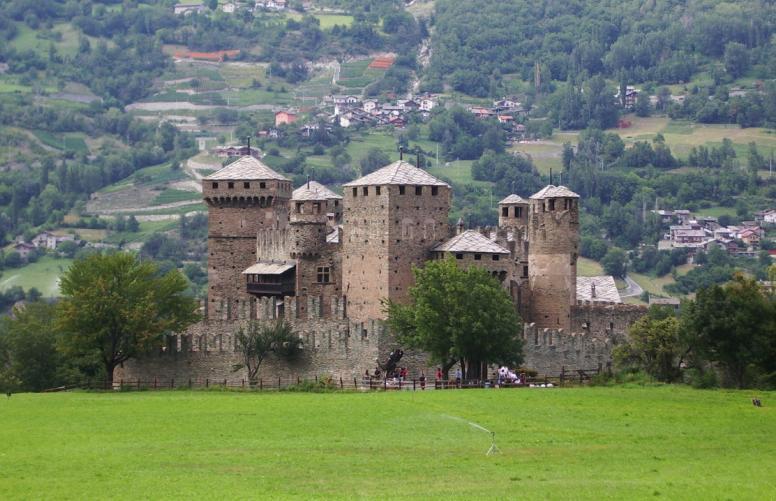Elegant crenellated towers stretch towards the sky but look almost small against the snow-capped bulk of the Alps. Even the tiny arrow slits that dot the thick grey walls fail to look threatening, and Fénis looks more out of the pages of Cinderella than of Ariosto’s knightly Orlando Furioso.
But then the castle was the showcase home of the Challant family, local lords who already controlled the Alpine passes of Val d’Aosta with many sturdy, menacing fortresses. They built it in the 13th century, then changed, renovated and expanded it over successive generations to reflect their wealth—until the 18th century, when their lifestyle overshot their income and they had to sell it on to settle some debts. After a period of decline, when the salons that had seen fierce knights and gentle dames were given over to cattle and hay, today Fénis looks once again like the opulent seat of power it was in the Middle Ages.
The visit is by guided tour only, but I hit it at the right time (lunchtime on a drizzly Sunday) and end up having my own private viewing of Middle Age life in northwestern Italy.
The guide takes me to a hidden entrance halfway round the inner ring of walls — even a scenic castle had serious security in place — which opens onto an irregular but lavish courtyard. A sweeping semi-circular staircase takes pride of place under a grandiose 15th century fresco of St George slaying the dragon. Just above it, a procession of finely painted saints, wise men and prophets watches over the long wooden balcony that links together the first floor rooms, which belonged to the lord and his family. There’s an enormous hall, which ends, rather unexpectedly, in a chapel, and the bedrooms, one of which has a bed so short my four-year-old son would be pushed to fit comfortably in it.
“Was it because they were so much smaller than us?” I ask. The guide smiles at my naïve question and replies that no, it is because they slept French style, nearly sitting on a pile of pillows and cushions.
“Lying down reminded them too much of dying,” he explains.
Below the ‘noble floor’ are the guards’ quarters, the dining room and the kitchen, which has one of the largest hearths I have ever seen. Three people can stand in it and still feel lost. Not only is it huge, but it also has a gigantic flue that had the extra purpose of warming up the rooms that bordered its length.
Although Fénis was built to impress, it also had another, more prosaic function — tax collection. From here, explains the guide, the Challants exacted tributes from tenants and, most of all, passing merchants, which is why one of the rooms on the ground floor was the tax collector’s office.
 As I leave the castle and head down towards the medieval-looking tavern at the foot of the hill — where I am forced to pay an exorbitant price for a model knight made in Germany (or else face the threat of a long-drawn tantrum) — I find myself sympathising with the merchants of yore who had to yield a portion of their riches to the Challants just for the privilege of passing by.
As I leave the castle and head down towards the medieval-looking tavern at the foot of the hill — where I am forced to pay an exorbitant price for a model knight made in Germany (or else face the threat of a long-drawn tantrum) — I find myself sympathising with the merchants of yore who had to yield a portion of their riches to the Challants just for the privilege of passing by.
But at least I can get a platter of good local food—perfectly cured mocetta, soft, creamy fontina, and candid lardo — at the same tavern for a pittance. Somehow I doubt the Challants offered their taxpayers that kind of service.




